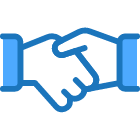What you should know before you start
The business case
The numbers
How unconscious bias might be getting in the way
Create a plan
Disability can be
Sources
Disability inclusion isn’t just about hiring people with disabilities. It’s also about:
- Increased profits
- Lower costs
- Improved productivity.
Your bottom line will improve, and as an added benefit, you’ll be helping strengthen Ontario’s economy.
If you have never worked with, or hired, a person with a disability, this website will help you get started. Good business practice and a positive attitude are really all you need to get started. In fact, the most challenging aspect of becoming an inclusive employer can be summed up by the phrase “but that’s the way I’ve always done it.”
If you are not an inclusive employer already, you are falling behind. Your competitors are already familiar with these numbers. Sign up with Magnet today to get started.
The business case
Hiring someone with a disability is the smart thing to do – the benefits are clear:
- Increase your productivity, profitability, and employee satisfaction.[1]
- Increase the size of your skilled labour pool.
90%
Rated average or better in job performance
40%
Lower accident rate. Work more safely
72%
Higher retention rate
87%
Rated average or better on attendance
The numbers
- People with disabilities are the largest minority group in Canada. This number is growing
- 6.2 million Canadians.
- 22% of the population
There are so many misconceptions about hiring people with disabilities. View our video about the most common ones and their counter facts.
People with disabilities are an under-utilized talent pool as hard-working and productive as employees without a disability. Approach your recruitment needs differently. The results will pay off.
Designing products and services for this growing market is a business opportunity. Employees with disabilities can offer valuable insight on how to develop new products and services that work better for everyone.
People with disabilities cross all ages, cultures, gender, citizenships, and creed. Unlike other groups, a person can join this group at any point in their life. Most disabilities are acquired as an adult.

How unconscious bias might be getting in the way
Every day we process thousands of pieces of information – sounds, sights, smells, and touch. If we had to think about each item distinctly, we would be overwhelmed. Our brains create mental shortcuts, ‘filling in the blanks’ to help us quickly manage all this information.
Mental shortcuts lead to stereotypes and unconscious bias in our decision-making. The shortcuts help us make fast decisions, but not necessarily the best decision.
Most employers have a list of items that they believe indicate someone will be a great hire. These ‘indicators’ are probably not based on fact. Often, they are based on ‘gut feel’ or ‘intuition’ – another word for unconscious bias.
Don’t let your practices and policies inadvertently prevent you from finding and keeping the right candidate.
- Unconscious bias and negative stereotypes. You may be unconsciously screening good candidates out of your hiring process by placing too much emphasis on non-job-related attributes such as appearance or mannerisms. Log on to TRIEC’s inclusive interviewing to identify some examples of how stereotypes might be preventing you from hiring the best candidate. You will have to register, but the training is provided free of charge. Or visit Microsoft’s eLesson on Unconscious Bias at https://www.mslearning.microsoft.com/course/72169/launch
- Discriminatory practices and policies. Did you know that asking a job seeker about their medical condition, or refusing to make a reasonable accommodation is discriminatory?
- Job websites that are not accessible. An accessible website demonstrates to job-seekers that you are open to hiring the best candidate, including people with disabilities.
- Résumés and job interviews are not always the best, or the only tools, to select the right hire. Hire the best person for the job, not the person with the best résumé. Be open to job developers, referrals and or atypical résumés.
- Work experience doesn’t indicate that the person did the job well, and it doesn’t indicate that a person can’t do the job. Be open to first-time job seekers, or individuals with limited work experience.
Create a plan
You need the plan to become an inclusive employer. Before you recruit and hire people with disabilities, have the tools and processes in place to train and support new employees.
Documentation
Completing paperwork that allows you to pay employees, offer benefits, or file a T4 at the end of the year is the standard operating procedure. A signed job offer spells out what the new employee will be responsible for, and when and where they’ll be doing it.
Adding some upfront and simple documents helps everyone you employ to do the best job possible, starting on day 1. Your job package should include the following:
- Written job offer, outlining duties, work schedule and compensation
- Emergency Procedures Protocol – include a fill-in section that accommodates new hires’ needs in the event of an emergency.
- Most people with disabilities know what they need to succeed on the job. Ask them, and if they require support, agree on what that will look like. This is called accommodation. Record the details so that you both understand what changes are needed. Maintain confidentiality and file it in their personnel record under the title Individual Accommodation Plan. You can download another example of How to develop an Individual Accommodation Plan at ORHMA (PDF, 484 KB).
Training
Before you start to recruit employees with disabilities, you should also talk to the rest of your staff, including supervisors, to address any concerns they might raise. It’s a pretty common reaction for people to worry the first time they try something new. This might be new to you, your staff and possibly even your customers. Training can help ease concerns.
Consider collaborating with an employment service agency or a disability organization. They can assist in helping you find job candidates, provide expertise and support on the job for new hires, and offer advice on the accommodations process.
Operating in Ontario
It’s good practice (and the law) to create and implement policies that promote accessibility. The Accessibility for Ontarians with Disability Act, or AODA, was created to break down barriers around accessibility.
The size and type of your business affect timelines, filing requirements, and obligations. Self-employed individuals and companies that do not have employees are exempt.
Some general areas that are addressed by the AODA include:
- Accessible Customer Service
- Accessible Emergency and Public Safety Information
- Creating Accessibility policies
- Training staff on accessible policies and laws
- Creating a feedback process for people with disabilities
- Making public information accessible (when requested)
- Making new websites, or significantly updated websites, accessible (50+ employees)
- Implementing accessible employment practices
- Filing Accessibility Compliance Reports
Visit AccessON to learn more.
Seize the competitive advantage. Don’t wait to be legislated to have to be inclusive – jump in and beat your competitors to the punch by signing up below.
Learn More:
AccessForward, with free training modules related to the AODA
Accessibility Directorate of Ontario links to Free Training
Disability can be
For many, the term “disability” suggests the image of wheelchair users. It makes sense, as the universal symbol for accessibility is an icon of a wheelchair user. Wheelchair users make up about 1.5% of the overall population or about 8% of people with disabilities[i]. We need to expand our idea of what disability is. Disability can be many things.
A productive way to re-think disability is to view it as doing things in a different way – which is also called innovation. Doing things differently doesn’t mean a person can’t do the job. But it might mean removing barriers and changing the ‘business as usual’ approach so that people with disabilities can contribute their skills in the workplace.
Disability covers a wide range of conditions. Even within the same disability, there is a great deal of variability. Disability can be:
- visible or invisible
- mild, moderate, or severe
- permanent, temporary, or episodic
- appear at birth or be acquired at any point during our lives.
Disclosure.
You probably know or employ a person with a disability. You likely have customers with disabilities. You may not, however, know who they are. Many people with disabilities choose not to disclose their private information or disability.
As an employer, you can, and should, ask, “do you require accommodation?” By asking this question, you can provide accommodations that allow the employee to be productive and do the job.
There is no single definition of disability. Some well-known types of disability include:
- Physical and mobility disabilities affect a person’s motor skills. They may require the use of mobility aids such as a wheelchair or a walking stick. Physical disabilities include conditions such as epilepsy, speech impediments, and neurological disorders like Tourette Syndrome and narcolepsy.
- Sensory disabilities affect a person’s senses: vision, hearing, smell, touch, or taste. This includes deafness, hearing loss, blindness, low vision, chemical sensitivities, colour blindness, being deafblind, and others.
- Intellectual and developmental disabilities affect a person’s ability to learn and use information, creating limitations in reasoning, learning, and problem-solving, as well as social and practical skill-building known as adaptive behaviours. Examples of intellectual and developmental disabilities include Autism spectrum disorder, Down syndrome, fetal alcohol spectrum disorder, and Apert syndrome.
- Learning disabilities are life-long conditions that affect how a person takes in, stores, or uses information. Learning disabilities can affect a person’s oral and written language, reading skills, mathematics skills, organization, or social skills. Examples include Dyslexia, Dysgraphia, Auditory Processing Disorder and Dyscalculia.
- Mental health conditions take many forms and can affect a person’s mental alertness, concentration, organization, and anxiety levels. Examples of mental health disabilities include Anxiety disorders, Depression, Post-Traumatic Stress Disorder, Obsessive Compulsive Disorder, and Bi-polar Disorder.
Be More Confident About Disability
Sources
[1] Mitchell, Lawrence, editor. Physical Disabilities: Perspectives, Risk Factors and Quality of Life. Chapter 2: Recruiting and Retaining People with Disabilities: A Scoping Review. Authors: Sally Lindsay, Athena Goodfellow, Mary Stergiou-Kita, Bonnie Kirsh and Donna Leroy. e-published (2017)
[2] DuPont/Australian Public Service Commission [APSC]. Ability at work: Tapping the talent of people with disability. Canberra: Commonwealth of Australia (2007)
[3] James P. Kaletta, Douglas J. Binks & Richard Robinson. Creating an Inclusive Workplace: Integrating Employees with Disabilities into a Distribution Centre Environment,” Professional Safety (June 2012)
[4] Graffam, Shinkfield, Smith and Polzin. “Employer Benefits and Costs of Employing a Person with a Disability.” Journal of Vocational Rehabilitation 17 (2002): 251-63.”
[5] Statistics Canada. 2006 Table 2, Population with and without disabilities, and disability rate, by province, Canada and provinces, 2006.
[6] Statistics Canada. 2012 Canadian Survey on Disability (CSD) (2012)
[7] United States Census Bureau (2012), pp. 8. . The number is derived from 1.5 percent: .015 /.187 (18.9% is the total number of people with disabilities – US number) = 8% of the population.
[8] United Spinal Association. Tips on Interacting with People with Disabilities.
[9] B Work®.
[10] Charity Village. Bias-free Hiring : Interview Questions not to ask.
[11] University of St Andrews, 5.3 Inclusive Interviews. Retrieved from
[12] Job Accommodation Network (2011). Workplace accommodations: Low cost, high impact. (Original 2005, Updated 2007, Updated 2009, Updated 2010, Updated 2011)
[13] Office of Disability Employment Policy, Business Strategies that Work: A Framework for Disability Inclusion. pp 5-7.







